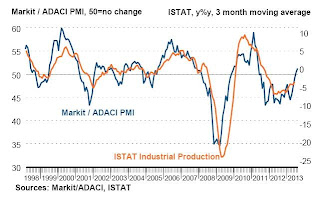The trend of the
last weeks
US 10 year
Government bond yields jumped from 2% on May 22nd – when Fed
President Mr. Bernanke
suggested that the Fed might cut back on bond purchases some time in “the next
few meetings” and the minutes of
April 30th/May 1st monetary policy meeting indicated that
“a number of participants expressed
willingness to adjust the flow of purchases downward as early as the June
meeting – to 2.61% on Monday
24th. From the lowest level touched on May 2nd at 1.63%
yields increased by 98bp.
The upward trend
of 10 year yields further strengthened following the Bernanke’s press
conference on June 19th, when he confirmed that that the central bank could
reduce its purchases this year and halt them around mid-2014. The acceleration
of the yields increase fuelled concerns that rising government bond yields
could have a negative impact on equity markets. However, S&P500 was so far
resilient, falling by a mere 3.4% from the historical high at 1655 set on May
22. On Wednesday 26th 10 year yields corrected to 2.52% as final Q1 GDP data
disappointed investors: indeed it was revised down from 2.4% to 1.8% annualized,
mainly due to weaker consumer spending growth.
Fed’s reaction
The strong
increase of Government bond yields alarmed Fed’s members. For example, Minneapolis
Fed President Narayana Kocherlakota said in an interview with CNBC on Wednesday
26th that the bond-market reaction to last week's Federal Reserve decision was
"outsized". He also highlighted that the Fed needs to defend its 2%
inflation target both from above and below.
Limited upside
potential
Our base
scenario is that from current level government bond yields have limited upside
potential. In our view, 10 year government yields will hardly exceed the 2.75%
target for year-end set by Deutsche Bank chief economist Joseph LaVorgna in a
recent note. Indeed we believe that the economic outlook does not support a
further increase of government yields.
First, because
US economy lacks a strong engine of growth in the next few quarters:
1) Consumer spending is likely to continue expanding at
moderate pace (1.5/2.0% annualized) as jobs creation remain weak;
2) Government spending contribute to economic growth will
soften for the spending cut become effective since March 1st;
3) Investments are likely to be negatively impacted by
the tightening of fiscal policy;
4) Exports will suffer due to weakening of economic
activity in emerging market and recession in the Euro zone.
Second, because
inflationary pressures are well contained and are not expected to pick up in
the foreseeable future.
The case for
being bullish
In our view, the
potential for a decline of Government bond yields in the months ahead is higher
than the potential for a further increase. In particular should economic
activity being weaker than Fed projections for a 2.4/2.5% GDP growth in 2013
and 3.2/3.3% in 2014.
A similar view
is shared by Jeffrey Gundlach, head of DoubleLine Capital LP. He said on
Tuesday 25th that “the selloff in the bond market is likely to end
in the next few weeks and that now is the time to consider buying riskier debt”.
Gundlach characterized the selloff in the bond market as a "liquidation
cycle" that will end within weeks, once the benchmark 10-year Treasury hits
a high of 2.75%.




